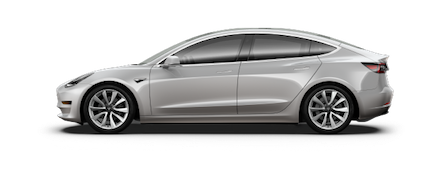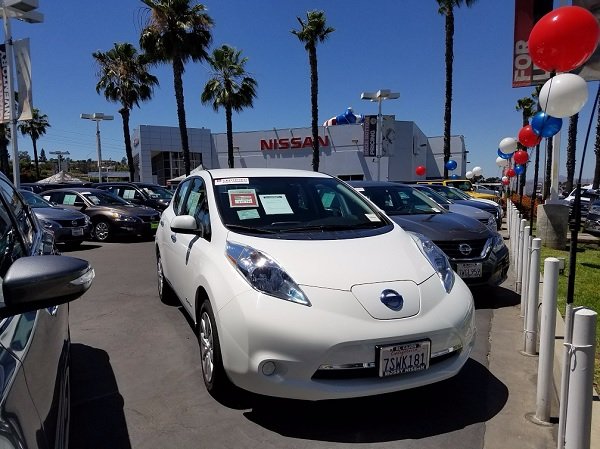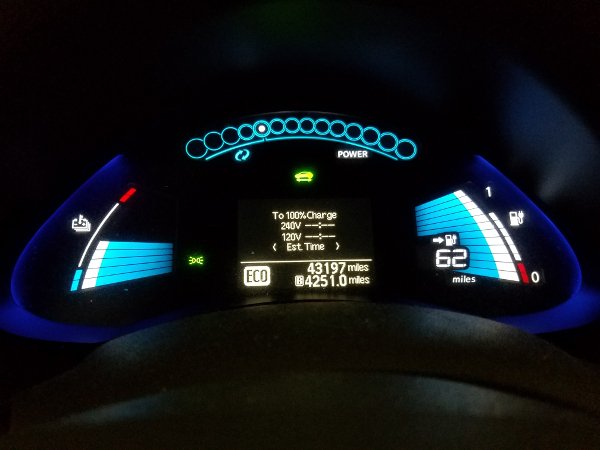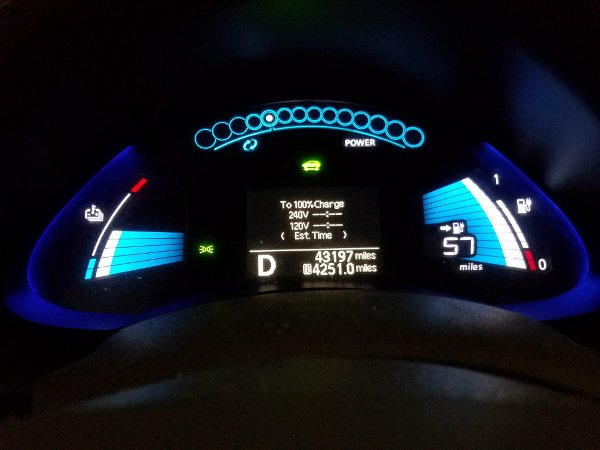Other pages
Search the site
Pages
Categories
Tesla Model 3 Promise Delivered Halfway

Tesla Model 3 meets delivery goal
Elon Musk said that the Model 3 would be delivered by the end of 2017. Very few, including me, believed him because Tesla had never delivered on time before. In fact the Model X was two years late. With the delivery of the first thirty customer cars Friday night, Musk is well ahead of schedule – at least for thirty lucky individuals.
The rest of the automotive world would call these production test vehicles. They built fifty cars and released thirty into the hands of employees. And maybe Tesla got the prospective owners to sign something acknowledging that the early delivery of these cars comes with some strings attached. But let’s face it – there are many that just need to be the first kid on the block with the shiny new toy and are willing to take the risk associated with such early adoption. I admit I was one of the first LEAF owners and have learned some valuable lessons from my experience. But based on previous company communications, these are all existing Tesla employees who will likely be forgiving of any tweaks needed as they get to show off their prizes well before most. Tesla also notes that early deliveries will go to existing Tesla owners as a reward for their loyalty. This approach is also likely to get more receptive welcomes from their new homes.
Tesla Model 3 doesn’t meet price goal
The number most talked about (other than the number 3) associated with the launch of this car is $35,000. As in, starting at $35,000 this will be the affordable Tesla. But, as is the case with all automobile makes, starting at does not equate to actual production. All initial production will come with the Long Range Battery option with a list price of $9,000. This takes it up to $44,000. But early owners will pay more than that as stated here in the information provided by the company in their Tesla Model 3 Reservations FAQ:
Will there still be a $35,000 Model 3 option?
Yes. Our first production Model 3 vehicles are preconfigured to ensure a smooth production ramp so that we can deliver more cars to more customers at a faster pace. The beginning configuration is a Long Range Battery with rear-wheel drive and premium upgrades, starting at $49,000. These vehicles come with three options for customization: wheel size, exterior color and Autopilot features.
Additional configurations, including the Model 3 with standard equipment for $35,000, will become available as production ramps, which we expect to be in November 2017.
In other words, all of the initial Tesla Model 3 production will have a starting price of $49,000 or more, depending on other premium upgrades. That is a forty percent premium to what many may have been expecting to pay. Tesla goes on to say that the Standard Battery option (as they put it) will start production in November 2017, so at least those looking for a more affordable Model 3 might be able to get one by the end of the year. Likely those will go to Tesla’s California owners. Still, there is no indication of how many of these entry level cars will be built, and even if they have the Standard Battery, many are likely to include other options that are likely to take the price into the $40,000 price range.
The standard battery will have a range of 220 miles and the Long Range battery will have a range of 310 miles. Years ago, early EV questionnaires found that a range of 150 miles would be satisfactory to EV owners. But this was when the LEAF, the most popular EV at the moment, offered a range of only 73 miles. Now even the Chevrolet Bolt offers a range of well over 200 miles. This has become the new de-facto minimum, as defined by the car-buying public. And when that car-buying public can buy a true 200 mile range EV for $35,000 that seats five comfortably, we will see EV sales ramp up much more quickly.
Posted in Industry News, Other EVs
Leave a comment
Nissan’s self-driving cars start arriving soon

2018 LEAF will drive itself – partially
Autonomous cars are the new thing. Cars that park themselves. Adaptive cruise-control that maintains a safe following distance between cars. The ability for cars to stop before running into the car that stops abruptly in front of them. Many of these technologies have made their way into everyday automobiles that the average person can actually afford. Nissan has announced that the 2018 Nissan LEAF will be available with their ProPILOT Assist technology. The 2018 LEAF will be revealed in early September and this technology takes it to the next level by providing single-lane driving assistance. Here we take a closer look.
Nissan has actually been working on autonomous cars for quite some time. In early 2013 I wrote an article about Nissan’s Silicon Valley Research Center expansion to develop a greater ability to analyze autonomous cars and their development. Later that year, Nissan put Japan’s first ever self-driving car on public roads for testing. At that time, Nissan stated their goal of having multiple commercially-viable autonomous drive vehicles available by 2020. So with the introduction of this technology to the US market later this year, they are on their way to achieving this goal. But this isn’t Nissan’s first ProPILOT Assist vehicle available to drivers. That honor belongs to the humble Serena minivan in the Japanese domestic market.
Serena

While the Serena may not look like much, it offers some of the most advanced technology available to today’s driver. And if you stop to think about it, what better vehicle to offer advanced safety features than a people hauler that likely has your kids in the back. Launched in 2016 in the Japanese market, Carlos Ghosn has said that 60 percent of Serena customers have opted for the technology. Also, LEAF is not the only vehicle expected to offer the self-driving technology – the European Qashqai (known as Rogue Sport in the US) will offer ProPILOT with the 2018 model year. That’s a pretty strong indication that we could see it make a stateside appearance on that model before long. So what does this feature actually do?
Here’s a look at a Nissan ProPILOT infographic:

In other words, ProPILOT takes much of the drudgery out of the daily commute for many Americans. Automatically slowing down with traffic, including stopping and then taking off again in stop-and-go traffic. Following bends in the road without needing your input. You know, all the stuff that’s hard to do while you’re texting your buddy from work while you should be driving.
As you can see at the bottom of the graphic, Nissan has plans to broaden the scope of the technology in the coming years. Stay tuned.
Should I buy a used Nissan LEAF?
 Or rather, why you should buy a used Nissan LEAF
Or rather, why you should buy a used Nissan LEAF
According to the California Plug-in Electric Vehicle Driver Survey Results – May 2013, 94 percent of EV owners also own a conventional fuel vehicle. Why do I lead with this? Because, the odds are, you are already a multiple-vehicle household. It likely would be very easy to replace one of your current vehicles with a used Nissan LEAF or other EV. Let’s tick off some of the reasons why this might make sense.
According to Autotrader.com, there are currently almost 1,100 Nissan LEAFs, model year 2011 through 2015 available across the country. The lowest priced LEAF is $4,988, highest priced is $21,339, and the average is $10,863. The $4,988 car has 82,503 miles on it and is already missing four bars, but it’s well beyond the five year, sixty thousand mile battery capacity warranty, so no free battery for you. The highest priced used LEAF is a 2015 S with 475 miles for $21,339. And it’s certified pre-owned as well, which provides additional warranty coverage (excluding the traction battery). Doing a sort by lowest price, there were well over 200 available for under $9,000 across the country, some with amazingly low miles (I saw a 2012 with 6,780 miles for $8,999 with all twelve bars).
That last comment is one of the important things to note when looking at a used LEAF. How many bars does it have left? I wrote an article that talks about losing bars, if you’re not familiar with the term, so I won’t go into it here. But you want to be careful to check how many battery capacity bars remain on the car that you’re looking at if driving range is important to you. Let’s use my really low priced example above. With four bars down, the range could be 50-60 miles, or it could be 40-50 miles depending on where you live and how you drive. Here is a picture of my 2012 LEAF with four bars down, fully charged, in ECO mode.

If all you do with your second car now is take the kids to school and go to the grocery store, that may be more than enough for your needs. If your current second car is more than five years old, you may be faced with expensive engine or drivetrain repairs over the next five years. You will also still be required to change the oil and filter, spark plugs, etc just to maintain it in good shape. One of the great things about an EV is that the vast majority of that maintenance goes away. It’s not that an EV needs no maintenance or repairs, but without all of the moving parts in a combustion engine and automatic transmission to fail, the most significant source of maintenance and repairs is also removed. EVs make excellent second cars for these reasons alone.
Let’s say you only drive your second car 10,000 miles each year, and it gets a pretty decent 25 miles per gallon. According to GasBuddy.com, the current low average price for regular gasoline is $1.99 per gallon in Oklahoma with a high of $3.04 in California. So let’s pick Colorado at $2.32 which is somewhere near the mean. Your 400 gallons needed to cover that annual mileage would cost you $928. According to fueleconomy.gov, the cost to drive a LEAF 25 miles is $0.97. Your fuel cost for the LEAF to cover the same distance would be $388. In other words, you are $540 to the good every year, just by selling your current car and getting a used LEAF. Not counting maintenance and repair savings. If you do happen to live in California, the state where the most EVs are currently sold in the US, your gas cost would be over $1,200. And that’s just in fuel costs. Also, in California, now you can commute in the carpool lane saving time and reducing stress if the range will allow it. Naturally these numbers will change based on your gas and electric costs, but you get the idea. Just by replacing your current second car with a LEAF you could give yourself a raise (much easier than trying to get one from your boss) and reduce potential future repair costs.
One last point, if you already have solar panels on your roof, and you’re selling excess capacity back to the grid (for pennies), your fuel bill goes to zero. Just sayin’…
One way to optimize your range

What’s on your wheels?
Not long ago I wrote an article about losing the fourth bar on my 2012 Nissan LEAF. When writing that article, I noticed that our fuel economy was 3.1 miles per kilowatt hour, which I had never really paid any attention to before. This is pretty low compared with many EV drivers that can achieve over 5 miles per kilowatt hour, extending their range significantly over mine. I know we drive with a lead foot occasionally, but this low efficiency didn’t make sense to me. So after thinking about it a bit, and wandering around online I went outside and looked at the tires. This story is a result.
We bought the car last year and it had gone through a local car dealership for reconditioning. As is often the case, they replaced the tires with the cheapest they could find. The tires that ended up on the car are Goodyear Assurance All Season M+S (mud and snow) tires. Just what I need to tool around the Greater San Diego area. Mud and Snow tires have a more aggressive tread pattern and a tread compound designed to optimize grip, not roll down the road easily. Original equipment tires on the car were low rolling resistance Bridgestone Ecopias. So the question becomes, how much can a tire impact fuel economy, and range, on an EV? This is what I found out with a little bit of research. Many others have studied the impact of tire rolling resistance from the U.S. Department of Energy to over-the-road truck drivers wishing to lower their operating costs. I also found some other interesting info from an off-road vehicle site that proved illuminating.
The Alternative Fuels Data Center found that installing low rolling resistance tires can improve fuel economy by about three percent on light duty vehicles, in other words, passenger cars. Just a ten percent decrease in rolling resistance can increase fuel economy by one percent to two percent. Heavy-duty vehicles can see improvements of over ten percent.
Perhaps the most interesting example I found was on an off-road vehicle site. They were curious about the same thing I was – how does tire type impact fuel economy. So they did a real-world test with a Ford F150HD – not the most fuel efficient vehicle on the planet. They tested two sets of LT (light truck) tires that were designed for two different purposes. One set was a street-oriented all-season tire while the other was an aggressive tread all-terrain tire. Their test discovered a whopping fifteen percent difference in fuel efficiency.
So I found that while our lead foot is a factor in some of our poor fuel efficiency, it is not the only factor. This tells us is that when you need to replace your EV tires (or really any vehicle that you’re interested in fuel economy) the type of tire that you chooses matters. If you are using less energy to roll down the road, you can roll farther. With a little online research you can find the most fuel efficient tire for your needs.
What four bars down looks like

Battery degradation in a 2012 Nissan LEAF
Battery degradation exists in electric cars, just as it does in mobile phones and laptops, but many people that are not familiar with electric cars have no idea what that is, or what it means. This article will help to fill in that knowledge gap.
First, let’s provide you with some background information. The above image was taken on May 28, 2017. This is a 2012 model Nissan LEAF SV that was sold originally, according to CARFAX, on January 11, 2013 and was built on July 21, 2012. It was sold in Southern California, and seems to have been driven in SoCal during its three year lease. I bought the car from a San Diego Nissan dealership in February of 2016 after it had come off lease. When I bought it, the car had 33,986 miles on it. So with this basic information in hand, you can see that we put under 10,000 miles on it in a fifteen month period. One other bit of important information – when we bought it, after only three years and roughly 34,000 miles it had already lost three bars of battery capacity. So that’s where we started with this car. It lost the fourth bar about fifteen months after we bought it.
If you look at the right side of the image, you will see two small red segments at the bottom right with six white segments above them. These are the battery capacity bars that LEAF drivers talk about. When this car was new, there were ten of those white segments above the red ones for a total of twelve bars. I will talk more about this battery degradation shortly. Just to the left of that, you can count 12 blue and white bars around the big 57 miles indicator. So when the car was new, the little white segments on the right would have matched all of the blue and white bars just to the left of them. These four missing white segments are what LEAF owners talk about when they talk about battery degradation. The longer blue and white bars are like a gas tank indicator on a gas-powered car. When full there are twelve bars, and as you use up the electricity stored in the battery, the blue and white bars start dropping off just like a fuel-tank indicator would. You will also see the big range remaining indicator count down toward empty.
As can be seen from the above image, the vehicle range as reported by the range remaining indicator is 57 miles at this point. The range remaining increases when placed in the Eco mode. Here is what it looks like in Eco.
 So in this case, you can see that the Eco mode provides roughly an additional nine percent in range. Often Eco mode will provide about an additional ten percent in range when driving around town. Eco mode doesn’t really add any range when driving on the freeway. This car is still suitable for all of our typical around-town usage, but may not be satisfactory for others. I have written another article (here) that will discuss some of the factors that can impact battery degradation.
So in this case, you can see that the Eco mode provides roughly an additional nine percent in range. Often Eco mode will provide about an additional ten percent in range when driving around town. Eco mode doesn’t really add any range when driving on the freeway. This car is still suitable for all of our typical around-town usage, but may not be satisfactory for others. I have written another article (here) that will discuss some of the factors that can impact battery degradation.
When new, the EPA combined range was 84 miles adjusting for their change in measurement parameters that they changed in 2013. As the battery degrades (loses bars) the range diminishes. These images show a full charge (all twelve blue and white bars illuminated) with a range of 57 in Drive mode. This is the mode that EPA measures the driving range. When your cell phone’s battery starts to age, your talk time decreases between charges. When it’s your car, your driving range decreases. That’s what battery degradation is.
Nissan has a battery capacity warranty that will provide a new battery for this LEAF under certain conditions. The capacity warranty says that when four bars are lost within 60 months or 60,000 miles of the original sale, they will restore the car to at least nine bars on these 24 kWh battery cars. On the newer 30 kWh battery cars, the capacity warranty is 96 months or 100,000 miles due to improved chemistry. In practice, Nissan has been replacing the entire battery pack restoring the range to new, which in this case the EPA says would be about 84 miles. Also, the chemistry of the replacement pack is improved over the original so it should degrade at a slower rate than the original and possibly provide slightly improved range over the original. Should you be outside the capacity warranty, the price to replace a battery is currently a little over $6,000. While that is a lot of money, one only need ask themselves this question: Do I want to spend $25,000 to $35,000 in a new car, or would it be better to spend $6,000 on my LEAF and drive it another five years?
Writing this article has created a couple of other areas of interest for me, so I’ll be writing about an easy way to optimize your range as your vehicle ages soon. I’ll also be writing about the possibility of getting a used LEAF or other electric car as your second family vehicle.

